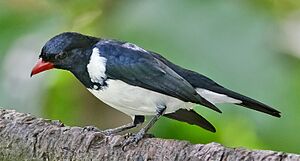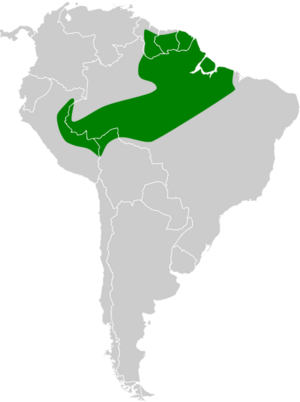Red-billed pied tanager facts for kids
Quick facts for kids Red-billed pied tanager |
|
|---|---|
 |
|
| Male | |
| Conservation status | |
| Scientific classification | |
| Genus: |
Lamprospiza
|
| Species: |
melanoleuca
|
 |
|
| Synonyms | |
|
Saltator melanoleucus Vieillot, 1817 |
|
The red-billed pied tanager (Lamprospiza melanoleuca) is a type of bird. It belongs to the family Mitrospingidae. You can find this bird in several South American countries. These include Bolivia, Brazil, French Guiana, Guyana, Peru, and Suriname.
For over 200 years, people thought this bird was a "true" tanager. These birds belong to the family Thraupidae. But in 2018, scientists decided it was different. They moved the red-billed pied tanager to its own family, Mitrospingidae.
Contents
About Its Name and Family
A French bird expert named Louis Pierre Vieillot first described this bird in 1817. He gave it the name Saltator melanoleucus. Over the years, other scientists gave it different names. Finally, in 1856, an English zoologist named Philip Sclater gave it its current scientific name.
The red-billed pied tanager and three other bird species used to be in the "true" tanager family. This family is called Thraupidae. But in 2013, a study showed they were not closely related. Scientists then suggested a new family for them.
Bird groups in North and South America agreed with this change. The International Ornithological Committee also agreed in 2018. Now, the red-billed pied tanager is the only bird in its group, called Lamprospiza. It does not have any different types or subspecies.
What It Looks Like
The red-billed pied tanager is about 17 to 18 cm (6.7 to 7.1 in) long. It weighs between 24 to 42 g (0.85 to 1.48 oz).
The male bird has a shiny blue-black head and upper body. Its throat and chest are black. The rest of its belly area is white.
The female looks similar to the male. But her neck, back, and rump (the area above the tail) are gray. Both male and female birds have a bright red bill, which is how they get their name.
Young red-billed pied tanagers look quite different. They have a black bill and a black head. Their upper back is white. The lower back has a mix of black and white spots. Their belly area is white with some black mixed in.
Where It Lives
The red-billed pied tanager lives in the upper Amazon Basin. This area stretches from eastern Peru and northern Bolivia. It goes east into central Brazil and north into the Guianas.
These birds live in the very top parts of humid forests. This top part is called the canopy. They can be found in tall trees up to about 900 m (3,000 ft) high. You might also see them at the edges of these forests.
How It Behaves
Feeding Habits
The red-billed pied tanager eats different things. Its diet includes berries, seeds, and beetles. It also eats parts of Cecropia trees.
These birds usually look for food in small groups. A group can have three to eight birds. Sometimes, they join other types of birds to feed together. They hop from branch to branch. Sometimes, they fly out quickly to catch insects in the air.
Reproduction
Scientists do not know much about how the red-billed pied tanager reproduces. A female bird was seen on a nest in Brazil in February. Young birds that had already learned to fly were seen in June and September in different parts of Brazil.
What It Sounds Like
The song of the red-billed pied tanager is complex. It sounds like a "jumbled series" of semi-musical notes. When a group of these birds calls out, it sounds like "ééé-ééh...ééé-ééé-ééh...ééé-ééh-yuu...".
Conservation Status
The IUCN (International Union for Conservation of Nature) has checked on the red-billed pied tanager. They have listed it as "Least Concern." This means the bird is not currently in danger of disappearing. It lives in a "reasonably large range" and does not have any clear threats.


